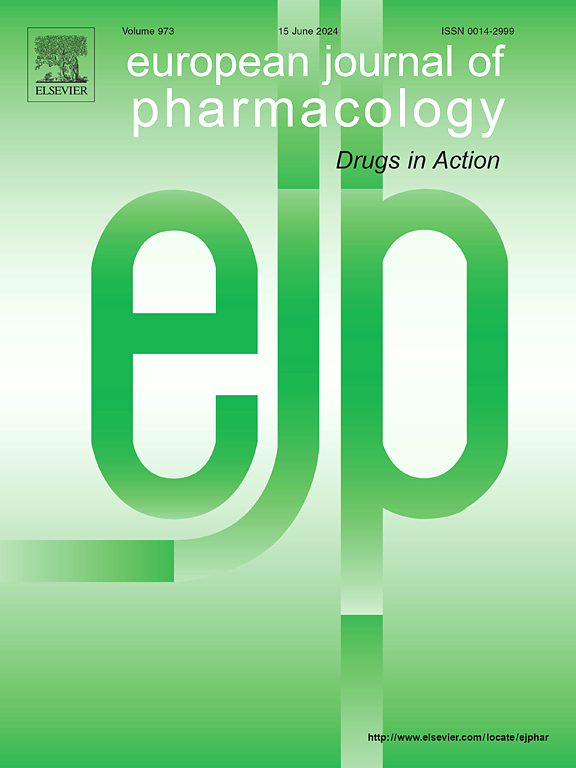Molsidomine ameliorates DEXA-induced insulin resistance: Involvement of HMGB1/JAK1/STAT3 signaling pathway
IF 4.2
3区 医学
Q1 PHARMACOLOGY & PHARMACY
引用次数: 0
Abstract
Insulin resistance (IR) is a serious clinical syndrome that establishes the basis for illnesses like type 2 diabetes (T2D). In this study, the effectiveness of molsidomine (MOLS) which is a nitric oxide (NO) doner, on dexamethasone (DEXA)- induced IR in rats was examined. Male Wistar rats were managed with MOLS (5 and 10 mg/kg) orally once daily for 7 days before DEXA injection (1 mg/kg, intraperitoneally (i.p.)) and 7 days concurrent with DEXA injection. The findings showed that MOLS reduced low-density lipoprotein cholesterol (LDL-C), fasting serum glucose and insulin, homeostatic model assessment of insulin resistance (HOMA-IR), alanine transaminase (ALT), aspartate transaminase (AST), oral glucose tolerance test (OGTT), and triglycerides (TGs). These findings revealed that MOLS was successful in reducing DEXA-induced IR. Moreover, MOLS was associated with a large increase in reduced glutathione (GSH) and superoxide dismutase (SOD) activity as well as a significant decrease in the levels of malondialdehyde (MDA) in hepatic and aortic tissues. When compared to rats treated with DEXA, MOLS significantly decreased the levels of pro-inflammatory cytokine interlukin-6 (IL-6), high mobility group box 1 (HMGB1), phosphorylated Janus kinase1/phosphorylated signal transducer and activator of transcription 3 (p-JAK1/p-STAT3), and nuclear factor kappa-B-p65 subunit (NF-κB-p65) in hepatic tissues. Additionally, MOLS reduced inflammation and necrosis and increased B cell/lymphoma 2 (BCL-2) and lowered caspase-3 levels and attenuated liver histopathological changes. Moreover, aortic expression levels of NF-κB-p65 and IL-6 were reduced upon MOLS treatment. All these findings show that MOLS protects rats from DEXA-induced IR by inhibiting HMGB1/JAK1/STAT3 signaling, regulating oxidative stress and inflammatory pathways, and having an antioxidant and anti-inflammatory effect.
莫西多明改善dexa诱导的胰岛素抵抗:HMGB1/JAK1/STAT3信号通路的参与
胰岛素抵抗(IR)是一种严重的临床综合征,是2型糖尿病(T2D)等疾病的基础。本研究观察了一氧化氮(NO)给药莫西多明(MOLS)对地塞米松(DEXA)诱导大鼠IR的影响。雄性Wistar大鼠口服MOLS(5和10 mg/kg),每天1次,连续7天,然后注射DEXA (1 mg/kg,腹腔注射),同时注射DEXA 7天。结果显示,MOLS降低低密度脂蛋白胆固醇(LDL-C)、空腹血糖和胰岛素、胰岛素抵抗稳态模型评估(HOMA-IR)、丙氨酸转氨酶(ALT)、天冬氨酸转氨酶(AST)、口服糖耐量试验(OGTT)和甘油三酯(tg)。这些发现表明MOLS能够成功地降低dexa诱导的IR。此外,MOLS与还原性谷胱甘肽(GSH)和超氧化物歧化酶(SOD)活性的大量增加以及肝脏和主动脉组织中丙二醛(MDA)水平的显著降低有关。与DEXA处理的大鼠相比,MOLS显著降低肝组织中促炎细胞因子白介素-6 (IL-6)、高迁移率组盒1 (HMGB1)、磷酸化Janus激酶1/磷酸化信号转导和转录激活因子3 (p-JAK1/p-STAT3)和核因子κ b -p65亚基(NF-κB-p65)的水平。此外,MOLS减少炎症和坏死,增加B细胞/淋巴瘤2 (BCL-2),降低caspase-3水平,减轻肝脏组织病理改变。此外,MOLS治疗降低了主动脉NF-κB-p65和IL-6的表达水平。上述结果表明,MOLS通过抑制HMGB1/JAK1/STAT3信号通路,调节氧化应激和炎症通路,具有抗氧化和抗炎作用,从而保护大鼠dexa诱导的IR。
本文章由计算机程序翻译,如有差异,请以英文原文为准。
求助全文
约1分钟内获得全文
求助全文
来源期刊
CiteScore
9.00
自引率
0.00%
发文量
572
审稿时长
34 days
期刊介绍:
The European Journal of Pharmacology publishes research papers covering all aspects of experimental pharmacology with focus on the mechanism of action of structurally identified compounds affecting biological systems.
The scope includes:
Behavioural pharmacology
Neuropharmacology and analgesia
Cardiovascular pharmacology
Pulmonary, gastrointestinal and urogenital pharmacology
Endocrine pharmacology
Immunopharmacology and inflammation
Molecular and cellular pharmacology
Regenerative pharmacology
Biologicals and biotherapeutics
Translational pharmacology
Nutriceutical pharmacology.

 求助内容:
求助内容: 应助结果提醒方式:
应助结果提醒方式:


